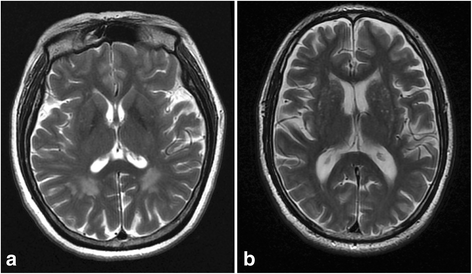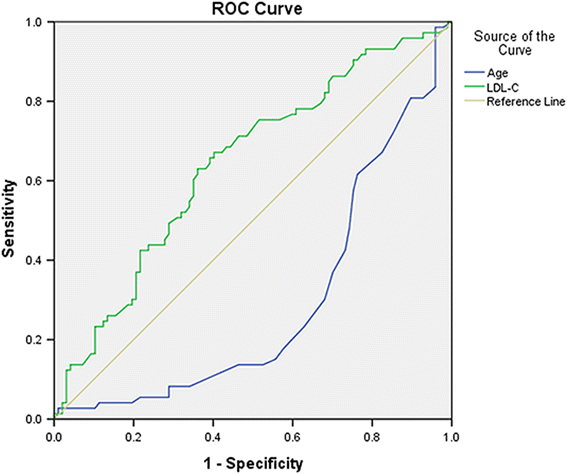Association between Low-density lipoprotein cholesterol and occipital periventricular hyperintensities in a group of Chinese patients: an observational study
- PMID: 28241772
- PMCID: PMC5327518
- DOI: 10.1186/s12944-017-0436-3
Association between Low-density lipoprotein cholesterol and occipital periventricular hyperintensities in a group of Chinese patients: an observational study
Abstract
Background: While occipital periventricular hyperintensities (OPVHs) are among the most common mild white matter hyperintensities, the clinical factors associated with OPVHs remain unclear. In this study, we investigated the role of clinical factors in development of pure OPVHs.
Methods: This study included 97 patients with OPVHs and 73 healthy controls. Univariate analysis of clinical factors in OPVH patients and controls was followed by binomial logistic regression analysis to identify clinical factors significantly associated with OPVHs.
Result: Univariate analysis indicated that age, total cholesterol (TC), low-density lipoprotein cholesterol (LDL-C) and apolipoprotein-B (Apo-B) levels differed significantly between the OPVH patients and controls (p < 0.05). Age and gender were correlated with OPVH scores (p < 0.05), while LDL-C, triglycerides, Apo-B and TC were anti-correlated with OPVHs scores (p < 0.05). Multivariate analysis indicated that LDL-C is negatively correlated with OPVHs (p < 0.05), and age is positively correlated with OPVHs (p < 0.001).
Conclusion: In summary, LDL-C was negatively and age was positively associated with OPVHs among Chinese patients in a hospital.
Keywords: Cardiovascular risk factor; Low-density lipoprotein cholesterol; MRI; Occipital periventricular hyperintensities; White matter hyperintensity.
Figures


Similar articles
-
Regional Gray Matter Atrophy Coexistent with Occipital Periventricular White Matter Hyper Intensities.Front Aging Neurosci. 2016 Sep 7;8:214. doi: 10.3389/fnagi.2016.00214. eCollection 2016. Front Aging Neurosci. 2016. PMID: 27656141 Free PMC article.
-
Memory impairment in occipital periventricular hyperintensity patients is associated with reduced functional responses in the insula and Heschl's gyrus.Int J Neurosci. 2017 Jun;127(6):493-500. doi: 10.1080/00207454.2016.1198345. Epub 2016 Jun 23. Int J Neurosci. 2017. PMID: 27323873
-
Association of the apolipoprotein B/apolipoprotein A-I ratio and low-density lipoprotein cholesterol with insulin resistance in a Chinese population with abdominal obesity.Acta Diabetol. 2012 Dec;49(6):465-72. doi: 10.1007/s00592-012-0419-9. Epub 2012 Sep 11. Acta Diabetol. 2012. PMID: 22965469
-
Low density lipoprotein cholesterol, lipoprotein(a), and apo(a) isoforms in the elderly: relationship to fasting insulin. Associazione Medica Sabin.Nutr Metab Cardiovasc Dis. 1999 Oct;9(5):228-33. Nutr Metab Cardiovasc Dis. 1999. PMID: 10656169
-
Effects of Canola Oil Consumption on Lipid Profile: A Systematic Review and Meta-Analysis of Randomized Controlled Clinical Trials.J Am Coll Nutr. 2019 Feb;38(2):185-196. doi: 10.1080/07315724.2018.1475270. Epub 2018 Oct 31. J Am Coll Nutr. 2019. PMID: 30381009
Cited by
-
Modulatory Effect of Blood LDL Cholesterol on the Association between Cerebral Aβ and Tau Deposition in Older Adults.J Prev Alzheimers Dis. 2024;11(6):1767-1774. doi: 10.14283/jpad.2024.131. J Prev Alzheimers Dis. 2024. PMID: 39559888 Free PMC article.
-
Nonhypertensive White Matter Hyperintensities in Stroke: Risk Factors, Neuroimaging Characteristics, and Prognosis.J Am Heart Assoc. 2023 Dec 5;12(23):e030515. doi: 10.1161/JAHA.123.030515. Epub 2023 Nov 28. J Am Heart Assoc. 2023. PMID: 38014679 Free PMC article.
-
Multi-Site Cross-Site Inter-Rater and Test-Retest Reliability and Construct Validity of the MarkVCID White Matter Hyperintensity Growth and Regression Protocol.J Alzheimers Dis. 2023;96(2):683-693. doi: 10.3233/JAD-230629. J Alzheimers Dis. 2023. PMID: 37840499 Free PMC article.
-
Association between cerebral small vessel disease and malnutrition risk: a retrospective cross-sectional study.Front Neurol. 2025 Jun 18;16:1512109. doi: 10.3389/fneur.2025.1512109. eCollection 2025. Front Neurol. 2025. PMID: 40606134 Free PMC article.
-
Association of Plasma Lipids with White Matter Hyperintensities in Patients with Acute Ischemic Stroke.Int J Gen Med. 2023 Nov 21;16:5405-5415. doi: 10.2147/IJGM.S440655. eCollection 2023. Int J Gen Med. 2023. PMID: 38021054 Free PMC article.
References
-
- Katsumata T, Otori T, Nishiyama Y, Okubo S, Nishiyama Y, Nagayama H, Ueda M, Utsumi K, Yamazaki M, Komaba Y, et al. Correlation between insulin resistance and white matter lesions among non-diabetic patients with ischemic stroke. Neurol Res. 2010;32:743–747. doi: 10.1179/016164109X12608733393755. - DOI - PubMed
Publication types
MeSH terms
Substances
LinkOut - more resources
Full Text Sources
Other Literature Sources
Medical
Miscellaneous

